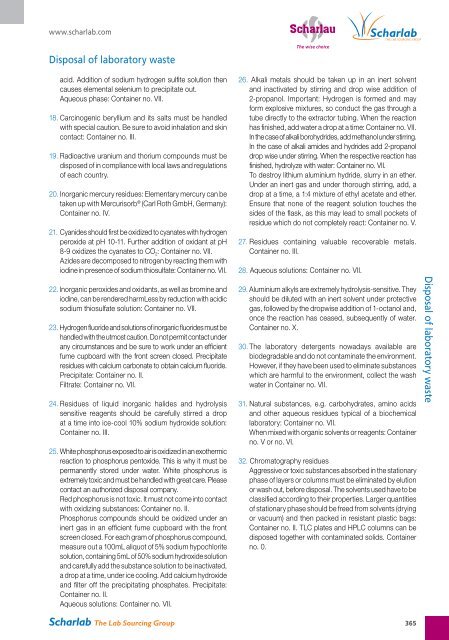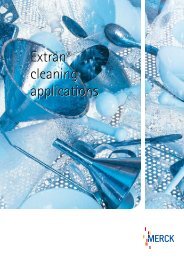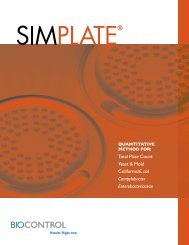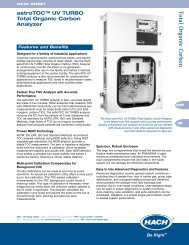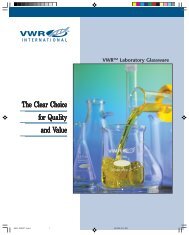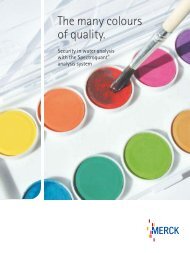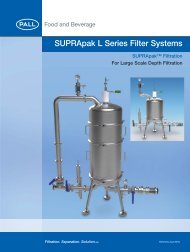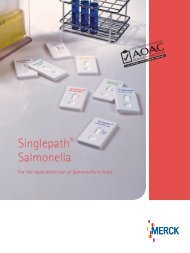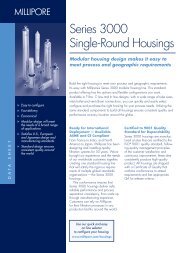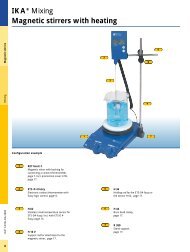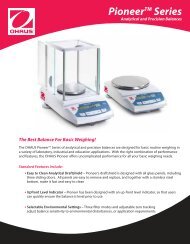- Page 3:
www.scharlab.comPresentationThe wis
- Page 7:
www.scharlab.comScharlab. The Lab S
- Page 10 and 11:
scharlab@scharlab.comProduct select
- Page 12 and 13:
scharlab@scharlab.comCustomised Pro
- Page 14 and 15:
The wise choicescharlab@scharlab.co
- Page 16 and 17:
scharlab@scharlab.comThe wise choic
- Page 18 and 19:
scharlab@scharlab.comThe wise choic
- Page 20 and 21:
scharlab@scharlab.comThe wise choic
- Page 22 and 23:
scharlab@scharlab.comSafety glass b
- Page 24 and 25:
scharlab@scharlab.comHolographic pr
- Page 26 and 27:
AC0050Acetamide, extra pureAcetaAce
- Page 28:
AC0351Acetic acid, solution 80% v/v
- Page 31 and 32:
AcetoAC0310 Acetone, Multisolvent
- Page 33:
AcetoAC0325 Acetonitrile, extra pur
- Page 36:
AC0326Acetonitrile, 99,9%, anhydrou
- Page 41 and 42:
AlizaRO0070Alizarin red S, C.I. 580
- Page 43:
AlumiAL0745KAl(SO 4 ) 2·12H 2 O•
- Page 47 and 48:
AmmonAM0271 Ammonium acetate, molec
- Page 49 and 50:
AmmonAM0274 Ammonium chloride, mole
- Page 51 and 52:
AmmonHI0315• M = 482,19 g/mol•
- Page 53 and 54:
AmmonAmmonium phosphate dibasic. Se
- Page 55 and 56:
AmylAL0128 n-Amyl alcohol, reagent
- Page 57:
AscorAC0515 L(+)-Ascorbic acid, rea
- Page 61 and 62:
BenzeBE0041 Benzene, Multisolvent
- Page 63 and 64:
BenzoBE0270 Benzoin, synthesis grad
- Page 65 and 66:
BenzyAL0161 Benzyl alcohol, reagent
- Page 67 and 68:
BlueAZ0220Blue tetrazolium, for mic
- Page 69 and 70:
BromoVE0070 Bromocresol green, indi
- Page 71 and 72:
BuffeSO1023Buffer solution pH = 3,0
- Page 73 and 74:
BuffeSO1143Buffer solution pH = 13,
- Page 75 and 76:
BuffeSO1013• Density: 0,96Buffer
- Page 77 and 78:
ButanAL0180 tert-Butanol, synthesis
- Page 79 and 80:
ButylME0553 tert-Butyl methyl ether
- Page 81 and 82:
CaffeCA0150 Caffeine anhydrous, ext
- Page 83 and 84:
CalciCA0198 Calcium chloride dihydr
- Page 85 and 86:
CalciCA0284 Calcium sulfate dihydra
- Page 87 and 88:
CedarAC0020 Cedar wood oil, thicken
- Page 89 and 90:
CharcCA0352 Charcoal activated, pow
- Page 91 and 92:
ChlorCL0120 1-Chlorobutane, HPLC gr
- Page 93 and 94:
ChlorCL0205 Chloroform, spectroscop
- Page 95 and 96:
ChlorCL0160 4-Chlorophenol, synthes
- Page 97 and 98:
CinchCI0240 Cinchonine, synthesis g
- Page 99 and 100:
CobalCO0045 Cobalt(II) nitrate hexa
- Page 101 and 102:
CoppeCO0092 Copper(II) acetate mono
- Page 103 and 104:
CoppeCO0096 Copper(II) sulfate pent
- Page 105 and 106:
CyanoBR0175 Cyanogen bromide, synth
- Page 107 and 108:
CycloCI0029C 6 H 12• M = 84,16 g/
- Page 109 and 110:
DeuteDE0038Heavy waterD 2 O• M =
- Page 111 and 112:
DichlDI0408 1,2-Dichloroethane, spe
- Page 113 and 114:
DichlCL0347CH 2 Cl 2• M = 84,93 g
- Page 115 and 116:
DichlCL0343 Dichloromethane, DNA sy
- Page 117 and 118:
DiethDI0580 Diethylene glycol monoe
- Page 119 and 120:
DiethSU0110 Diethyl sulfate, extra
- Page 121 and 122:
DimetDI0855 N,N-Dimethylacetamide,
- Page 123 and 124:
DimetDI0937 4-(Dimethylamino)-benza
- Page 125 and 126:
DimetDI1066 N,N-Dimethylformamide,
- Page 127 and 128:
DimetFT0055 Dimethyl phthalate, syn
- Page 129 and 130:
DimetSU0158C 2 H 6 OS• M = 78,13
- Page 131 and 132:
DioxaDI1290C 4 H 8 O 2• M = 88,11
- Page 133 and 134:
DipheDI0660 1,5-Diphenylcarbazone,
- Page 135 and 136:
EosinEO0056 Eosin methylene blue, s
- Page 137 and 138:
EthanET0006 Ethanol absolute, extra
- Page 139 and 140:
EthanET0011 Ethanol absolute, molec
- Page 141 and 142:
EthanET0040 Ethanolamine hydrochlor
- Page 143 and 144:
EthylAC0158 Ethyl acetate, LC-MSAce
- Page 145 and 146:
EthylCA0319 Ethyl caprylate, synthe
- Page 147 and 148:
EthylAC0970• M = 372,24 g/mol•
- Page 149 and 150:
EthylET0182 Ethylene glycol monoeth
- Page 151 and 152:
EthylEthyl octanoate. See Ethyl cap
- Page 153 and 154:
FluorFL0122 Fluorescein sodium, C.I
- Page 155 and 156:
FormaFO0028 Formamide, dried (max.
- Page 157 and 158:
FuchsFU0065 Fuchsin basic, carbol s
- Page 159 and 160:
GlucoGL0127 D(+)-Glucose anhydrous,
- Page 161 and 162:
GlyciAC0402 Glycine, extra pure, Ph
- Page 163 and 164:
GumGO0020Gum arabic, pure, powder,
- Page 165 and 166:
HeptaHE0130 n-Heptane, 99%, spectro
- Page 167 and 168:
Hexad2,4-Hexadienoic acid. See Sorb
- Page 169 and 170:
HexanHE0239 n-Hexane, 96%, GC ultra
- Page 171 and 172:
HexanAC0680 Hexanoic acid, synthesi
- Page 173 and 174:
HydraHI0089 Hydrazine hydrate, solu
- Page 175 and 176:
HydroAC0767 Hydrochloric acid, solu
- Page 177 and 178:
HydroAC0754 Hydrochloric acid, solu
- Page 179 and 180:
HydroHI0132 Hydrogen peroxide, solu
- Page 181 and 182:
ImidaIM0025 Imidazole, synthesis gr
- Page 183 and 184:
IodinYO0027 Iodine, solution 0,0236
- Page 185 and 186:
IronHI0352Iron(III) sulfate hydrate
- Page 187 and 188:
IsoheIS0122 Isohexane, Multisolvent
- Page 189 and 190:
KanamKA0010 Kanamycin sulfate, mole
- Page 191 and 192:
KarlKarl Fischer coulometric reagen
- Page 195 and 196:
LeadPL0115 Lead(II) acetate trihydr
- Page 197 and 198:
LevulLevulose. See D(-)-Fructose pa
- Page 199 and 200:
LysinLI0035 L-Lysine monohydrochlor
- Page 201 and 202:
MagneMA0060 Magnesium oxide, extra
- Page 203 and 204:
MalicAC1420 DL-Malic acid, extra pu
- Page 205 and 206:
MannoMA0160 D(+)-Mannose, for bioch
- Page 207 and 208:
MercuME0169 Mercury(II) chloride, e
- Page 209 and 210:
MethaME0300 Methanol, synthesis gra
- Page 211 and 212:
MethaME0306 Methanol, supragradient
- Page 213 and 214:
MethaME0313CD 3 OD• M = 36,07 g/m
- Page 215 and 216:
MethyME0355 Methylammonium chloride
- Page 217 and 218:
MethyMethyl glycol. See Ethylene gl
- Page 219 and 220:
MethyME0496 1-Methyl-2-pyrrolidone,
- Page 221 and 222:
MilloRE0040Millonʼs reagent• Den
- Page 223 and 224:
MohrMohr’s salt . See Ammonium ir
- Page 225 and 226:
NaphtNA0026 Naphthalene, pellets ap
- Page 227 and 228:
NickeNI0132 Nickel, powder, extra p
- Page 229 and 230:
NitriAC1614Nitric acid, 69%, ppb-tr
- Page 231 and 232:
NitroNI0225 3-Nitroaniline, synthes
- Page 233 and 234:
NitroNI0390 1-Nitroso-2-naphthol, r
- Page 235 and 236:
OrangAC0033 Orange essential oilOil
- Page 237 and 238:
OxaliAC1724 Oxalic acid, solution 0
- Page 239 and 240:
PentaPE0092 n-Pentane, 95%, synthes
- Page 241 and 242:
PepsiPE0125 Pepsin 1:10000 NFPuerzy
- Page 243 and 244:
PetroET0095• CAS [64742-49-0]•
- Page 245 and 246:
PheneFE0135 p-Phenetidine, synthesi
- Page 247 and 248:
Pheny3-Phenylallyl alcohol. See Cin
- Page 249 and 250:
PhospAN0215 di-Phosphorus pentoxide
- Page 251 and 252:
PIPESPI0062 PIPES, sesquisodium sal
- Page 253 and 254:
PolyvPO0080 Polyvinylpyrrolidone, m
- Page 255 and 256:
PotasPO0170 Potassium carbonate, ex
- Page 257 and 258:
PotasPO0216 Potassium chromate, sol
- Page 259 and 260:
PotasPO0218 Potassium dichromate, s
- Page 261 and 262:
PotasPO0240 Potassium hexacyanoferr
- Page 263 and 264:
PotasPO0272 Potassium hydrogen sulf
- Page 265 and 266:
PotasPO0278 Potassium hydroxide, et
- Page 267 and 268:
PotasPO0279 Potassium nitrate, pure
- Page 269 and 270:
PotasPO0336 Potassium permanganate,
- Page 271 and 272:
PotasPO0370 Potassium thiocyanate,
- Page 273 and 274:
PropaAL0323 2-Propanol, analytical
- Page 275 and 276:
PropaAL0317 2-Propanol, 99,8%, anhy
- Page 277 and 278:
PyridPI0121 Pyridine, extra pureC 5
- Page 279 and 280:
QuiniQU0095 Quinine sulfate dihydra
- Page 281 and 282:
SafraSA0042 Safranine O, solution a
- Page 283 and 284:
SilicGE0048SiO 2• M = 60,09 g/mol
- Page 285 and 286:
SilvePL0040 Silver chromate, synthe
- Page 287 and 288:
SilvePL0072AgSO 4• M = 311,79 g/m
- Page 289 and 290:
SodiuSO0091 Sodium azide, extra pur
- Page 291 and 292:
SodiuSO0050 Sodium carbonate, solut
- Page 293 and 294:
SodiuSO0250 Sodium chromate, reagen
- Page 295 and 296:
SodiuSO0333 Sodium dihydrogen phosp
- Page 297 and 298:
SodiuSO0415 Sodium hexametaphosphat
- Page 299 and 300:
SodiuSO0339Na 2 HPO 4·2H 2 O• M
- Page 301 and 302:
SodiuSO0422 Sodium hydroxide, solut
- Page 303 and 304:
SodiuSO0444 Sodium hydroxide, solut
- Page 305 and 306:
SodiuSO0436 Sodium hypochlorite, so
- Page 307 and 308:
SodiuSO0564 Sodium metaperiodate, e
- Page 309 and 310:
SodiuSO0530 di-Sodium oxalate, reag
- Page 311 and 312:
SodiuSO0615 Sodium rhodizonate, ind
- Page 313 and 314:
SodiuSO0700 di-Sodium tartrate dihy
- Page 315 and 316:
SodiuSO0737 Sodium thiosulfate, sol
- Page 317 and 318:
StandStandards, AAAL0751• Density
- Page 319 and 320:
StandMA0011• Density: ~ 1,02Magne
- Page 321 and 322:
StandStandards, ICP single elementA
- Page 323 and 324:
StandEU0051• Density: 1,03Europiu
- Page 325 and 326:
StandME0115• Density: 1,03Mercury
- Page 327 and 328:
StandES0020• Density: 1,03Scandiu
- Page 329 and 330:
StandIT0003• Density: 1,03Ytterbi
- Page 331 and 332:
StandCL0228 Chloride, standard solu
- Page 333 and 334:
StarcAL0719 Starch, solution 2 %(C
- Page 335 and 336:
SudanSU0040 Sudan III, C.I. 26100,
- Page 337 and 338:
SulfuAC2067Sulphuric acidH 2 SO 4
- Page 339 and 340: SulfuAC2109 Sulfuric acid, solution
- Page 341 and 342: SulfuAC2076 Sulfuric acid, solution
- Page 343 and 344: TetraTE0118 Tetrabutylammonium chlo
- Page 345 and 346: TetraAL0360 1-Tetradecanol, synthes
- Page 347 and 348: TetraTe0229C 4 H 8 O• M = 72,11 g
- Page 349 and 350: ThiogAC3080 Thioglycolic acid, solu
- Page 351 and 352: TinES0063Tin(II) chloride dihydrate
- Page 353 and 354: TolueTO0085 Toluene, Multisolvent
- Page 355 and 356: TolueAC3120 Toluene-4-sulfonic acid
- Page 357 and 358: TrichAC3134 Trichloroacetic acid, s
- Page 359 and 360: TrietTR0216Triethylamine, reagent g
- Page 361 and 362: TriflTR01602,2,2-Trifluoroethanol,
- Page 363 and 364: TrishTR0422 Tris-(hydroxymethyl)-am
- Page 365 and 366: TweenTW0040 Tween ® 40, extra pure
- Page 367 and 368: VaselAC0030 Vaseline oil, extra pur
- Page 369 and 370: WaterAG0010 Water with 0,1% ammoniu
- Page 371 and 372: XylenAN0090 Xylenol orange, tetraso
- Page 373 and 374: ZincoCI0225 Zincon, for the photome
- Page 375 and 376: www.scharlab.comSingle-use containe
- Page 377 and 378: www.scharlab.comSingle-use containe
- Page 379 and 380: www.scharlab.comThe wise choiceScha
- Page 381 and 382: www.scharlab.comThe wise choiceCult
- Page 383 and 384: www.scharlab.comThe wise choiceCult
- Page 385 and 386: www.scharlab.comHPLC Scharlau colum
- Page 387 and 388: www.scharlab.comThe wise choiceScha
- Page 389: www.scharlab.comThe wise choiceDisp
- Page 393 and 394: www.scharlab.comReferences indexThe
- Page 395 and 396: www.scharlab.comReferences indexThe
- Page 397 and 398: www.scharlab.comReferences indexThe
- Page 399 and 400: www.scharlab.comReferences indexThe
- Page 401 and 402: www.scharlab.comReferences indexThe
- Page 403 and 404: www.scharlab.comReferences indexThe
- Page 405 and 406: www.scharlab.comReferences indexThe
- Page 407 and 408: www.scharlab.comCAS indexThe wise c
- Page 409 and 410: www.scharlab.comCAS indexThe wise c
- Page 411 and 412: www.scharlab.comCAS indexThe wise c
- Page 413 and 414: www.scharlab.comProduct family inde
- Page 415 and 416: www.scharlab.comProduct family inde
- Page 417 and 418: www.scharlab.comProduct family inde
- Page 419 and 420: www.scharlab.comProduct family inde
- Page 421 and 422: www.scharlab.comProduct family inde
- Page 423 and 424: www.scharlab.comProduct family inde
- Page 425 and 426: www.scharlab.comProduct family inde
- Page 427 and 428: www.scharlab.comProduct family inde
- Page 429 and 430: www.scharlab.comNotesThe wise choic
- Page 431 and 432: www.scharlab.comNotesThe wise choic


